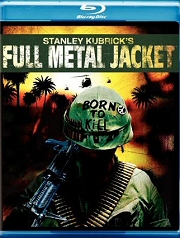Matthew Modine, R. Lee Ermey, Vincent D'Onofrio, Adam Baldwin, Dorian Harewood, Kevyn Major Howard
- Rated R
- Drama
- 1987
- Buy the BD
Reviewed by Jason Newman
he Marine Corps does not want robots. The Marine Corps wants killers. The Marine Corps wants to build indestructible men. Men without fear.”
It had been seven years since Stanley Kubrick released the hotel horror film “The Shining” to near-universal acclaim. In the intervening years, Hollywood developed an increasingly torrid infatuation with the Vietnam War, releasing a string of films ranging from classic (“Platoon”) to forgettable (“Thou Shalt Not Kill…Except”). With 1987’s “Full Metal Jacket,” based upon the novel “The Short Timers” by Gustav Hastord, Kubrick expertly parallels and contrasts the humiliation and regimentation of Marine Corps basic training with the war itself, culminating in a harrowing encounter between American soldiers and a Vietcong sniper.
Unlike similarly-themed films (“Hamburger Hill,” “Birdy,” “Bat 21,” etc.), “Full Metal Jacket” plays as almost two separate movies. In part one, we see Modine (in a role originally intended for Anthony Michael Hall), D’Onofrio and others submit to the hellacious, fear-inducing Drill Instructor Gunnery Sergeant Hartman, as played by real-life DI R. Lee Ermey. When preparing for war, mercy and sympathy take a backseat to order, discipline and homogeneity. Hartman spits a seemingly interminable litany of vitriol and invectives at his “maggots” – “You had best unfuck yourself or I will unscrew your head and shit down your neck!” being one of the tamest – driving each soldier to either razor-sharp mental acuity or gradual insanity.
Part two sees some of the soldiers now in Vietnam, talking to local prostitutes (thus providing the sample for 2 Live Crew’s lewd classic, “Me So Horny”) and preparing for their next assignment. Kubrick effectively shows both the drudgery and action of life during wartime, eschewing moral high ground in favor of a neutral, journalistic tone in line with Modine’s wartime occupation of military reporter.
Many reviews that came out at the time noted the unfortunate timing of “Platoon,” a film whose battle scenes overshadow “Full Metal Jacket” in creativity, realism, and technical virtuosity. But where “Full Metal Jacket” excels is its diverse characterizations and stellar cast, led by Modine, D’Onofrio and Ermey. Beating out De Niro’s record weight gain for “Raging Bull,” D’Onofrio packed on 70 pounds to play the role of Leonard “Gomer Pyle” Lawrence, a dim-witted recruit unable to handle the constant abuse from both Hartman and his fellow recruits. Like Malcolm McDowell in “A Clockwork Orange” and Jack Nicholson in “The Shining,” D’Onofrio’s chilling stare – the close-up shot of an increasingly tormented character a Kubrick trademark – lingers with the viewer long after the film’s end. Modine plays James “Joker” Davis with a solid mix of sarcasm, cynicism and obedience, yet it’s Ermey, initially brought on set as a technical advisor to the cast, who delivers a performance that, while not as nuanced, is every bit as powerful and memorable as Peter Sellers in “Lolita” or Kirk Douglas in “Spartacus.”
Kubrick has long been known as a meticulous, detail-driven filmmaker, and while “Full Metal Jacket” contained less takes and more improvisation than his past movies (due largely to Ermey’s on-the-spot cascade of insults), the filmmaker still spent years preparing for the shoot. Research for “Full Metal Jacket” began in 1983, with the director watching countless documentaries, studying Vietnam-era photographs and reading Vietnamese newspapers written during the war. In the film, Kubrick combines the realism of “Paths of Glory” with the irony of “Dr. Strangelove” – most tellingly in the recurring usage of “Mickey Mouse” during basic training and at the end of the film – for a singular look at war and its effects. “Full Metal Jacket” is not the best Kubrick film in his oeuvre, but nearly 25 years later, it still stands as a timeless meditation on war and its effects.
You can follow us on Twitter and Facebook for content updates. Also, sign up for our email list for weekly updates and check us out on Google+ as well.












